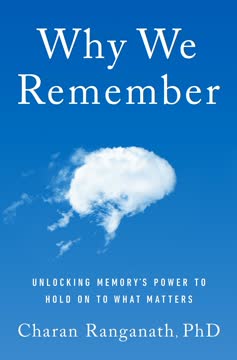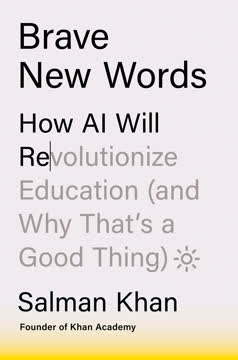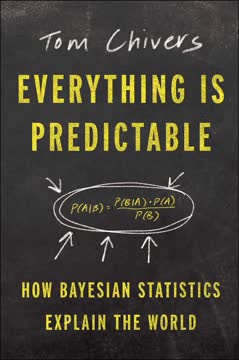Key Takeaways
1. Embrace probabilistic thinking to navigate uncertainty
Science offers us a radically different way to think about our connection to this reality that we know something, but not everything, about.
Shift from binary to probabilistic thinking. In a world full of uncertainties, adopting a probabilistic mindset allows for more nuanced and accurate decision-making. This approach involves:
- Expressing confidence levels in statements (e.g., "I'm 75% confident that...")
- Recognizing that even experts can be wrong sometimes
- Updating beliefs based on new evidence
By embracing probabilistic thinking, we can:
- Make better decisions with incomplete information
- Avoid overconfidence in our beliefs
- Be more open to changing our minds when presented with new data
2. Distinguish signal from noise in complex information
If you hunt for a signal in random noise, you often think you see a signal when in fact there isn't one.
Develop critical analysis skills. In today's information-rich environment, it's crucial to differentiate meaningful patterns (signal) from random fluctuations (noise). This involves:
- Understanding statistical significance and sample sizes
- Recognizing common pitfalls like the "look elsewhere effect"
- Using techniques like blind analysis to avoid confirmation bias
Key strategies for distinguishing signal from noise:
- Look for replicable results across multiple studies
- Be skeptical of patterns that seem too good to be true
- Consider alternative explanations for observed correlations
3. Overcome cognitive biases through scientific methods
Kahneman argued that overconfidence is the one human bias "he would most like to eliminate if he had a magic wand."
Recognize and mitigate biases. Human cognition is prone to various biases that can lead to flawed reasoning and decision-making. Scientific thinking offers tools to counteract these biases:
- Confirmation bias: Actively seek out disconfirming evidence
- Availability heuristic: Consider base rates and statistical data
- Anchoring bias: Use multiple reference points for estimates
Strategies for overcoming biases:
- Practice "considering the opposite" to challenge your assumptions
- Use structured decision-making processes to reduce emotional influence
- Collaborate with diverse groups to expose blind spots in your thinking
4. Cultivate scientific optimism and persistence
Scientific optimism did keep them going — but it is important to see how this works in practice.
Adopt a can-do attitude. Scientific progress often requires perseverance in the face of setbacks and failures. Cultivating scientific optimism involves:
- Believing that problems are solvable, given enough time and effort
- Embracing an iterative approach to problem-solving
- Maintaining motivation through small, incremental successes
Benefits of scientific optimism:
- Encourages tackling difficult, long-term challenges
- Fosters creativity and innovation in problem-solving
- Builds resilience in the face of setbacks and failures
5. Harness the power of collective intelligence
The goal is not to come to consensus. It's not like a jury, where everyone has to agree. However, by the end of the event, people have often changed their minds.
Leverage group wisdom. Collective intelligence can often outperform individual expertise when properly harnessed. Effective group decision-making involves:
- Diverse perspectives and backgrounds
- Structured deliberation processes
- Mechanisms for aggregating individual judgments
Techniques for harnessing collective intelligence:
- Deliberative Polling: Informed citizen participation in policy decisions
- Prediction markets: Aggregating forecasts through financial incentives
- Superforecasting: Identifying and leveraging top performers in prediction tasks
6. Integrate facts and values in decision-making
Facts don't tell us what to do once we have them.
Balance evidence and ethics. Effective decision-making requires integrating factual information with value judgments. This involves:
- Separating empirical claims from normative statements
- Recognizing the role of emotions and personal values in decisions
- Using structured frameworks to weigh different factors
Steps for integrating facts and values:
- Clearly define the problem and desired outcomes
- Gather relevant factual information from credible sources
- Identify stakeholders and their values/priorities
- Use decision-making tools (e.g., cost-benefit analysis, multi-criteria decision analysis)
- Consider potential unintended consequences and ethical implications
7. Build trust through open-mindedness and collaboration
We well know that a "made with science" label on the cover of any argument is not sufficient reason to accept the argument.
Foster a culture of trust and cooperation. Building trust in scientific institutions and collaborative problem-solving requires:
- Transparency in research methods and data
- Willingness to admit mistakes and update beliefs
- Engaging diverse perspectives in decision-making processes
Strategies for building trust:
- Practice open science: Pre-registration, data sharing, and replication efforts
- Encourage constructive criticism and debate within scientific communities
- Communicate uncertainties and limitations of scientific findings to the public
- Develop collaborative platforms for citizen science and public engagement
By adopting these principles of Third Millennium Thinking, we can navigate complex challenges, make better decisions, and build a more trustworthy and effective scientific enterprise.
Last updated:
FAQ
What's Third Millennium Thinking about?
- Focus on Decision-Making: The book explores how to make sound decisions amidst the overwhelming information available today, using scientific thinking.
- Interdisciplinary Approach: It combines insights from physics, philosophy, and psychology to provide tools for clearer thinking and effective problem-solving.
- Coping with Uncertainty: Emphasizes understanding uncertainty and using probabilistic thinking to improve decision-making in complex situations.
- Scientific Thinking Tools: Highlights the importance of scientific thinking to navigate misinformation and biases in a complex world.
Why should I read Third Millennium Thinking?
- Practical Tools: Offers practical tools and frameworks applicable to everyday decision-making, relevant for a wide audience.
- Addressing Modern Challenges: Tackles issues like misinformation, polarization, and collaborative decision-making challenges in a complex world.
- Empowerment Through Knowledge: Empowers readers to evaluate information and expertise confidently, crucial in today’s information-rich environment.
- Promoting Collaborative Solutions: Emphasizes collaboration and collective intelligence for more effective and inclusive societal solutions.
What are the key takeaways of Third Millennium Thinking?
- Probabilistic Thinking: Assign probabilities to beliefs and decisions for a nuanced understanding of uncertainty.
- Signal vs. Noise: Learn to differentiate between meaningful signals and distracting noise in data for accurate decision-making.
- Collaborative Problem-Solving: Encourages diverse perspectives to enhance understanding and improve collective decision-making processes.
- Understanding Cognitive Biases: Recognize and mitigate biases like confirmation bias and groupthink to improve judgment and collaboration.
What is the significance of "probabilistic thinking" in Third Millennium Thinking?
- Confidence Levels: Allows individuals to express confidence in statements, aiding informed decisions based on varying certainty levels.
- Iterative Learning: Promotes continuous learning and adaptation, revising decisions as new information becomes available.
- Real-World Applications: Applicable in fields like medicine and policy-making, where uncertainty is a constant factor.
How do the authors define "signal" and "noise" in Third Millennium Thinking?
- Signal: Refers to meaningful information or patterns indicating a specific phenomenon or trend.
- Noise: Represents irrelevant or random data that can obscure the signal, complicating true information discernment.
- Context-Dependent: The distinction between signal and noise varies based on the observer's goals and context.
What is Fermi estimation, and how is it used in Third Millennium Thinking?
- Quick Estimation Technique: A method for making rough calculations based on known quantities and logical reasoning.
- Differentiating Factors: Helps distinguish between first-order (primary) and second-order (secondary) factors in complex problems.
- Empowerment Through Estimation: Fosters confidence in understanding and engaging with the world, promoting a sense of agency.
What is the "look elsewhere effect" in Third Millennium Thinking?
- Pattern Recognition: Occurs when searching for multiple patterns in data, increasing the likelihood of finding false signals by chance.
- Statistical Implications: Highlights the importance of predefining hypotheses and limiting variables to avoid misleading conclusions.
- Real-World Consequences: Can lead to erroneous claims in research, emphasizing the need for rigorous study design and analysis.
How does Third Millennium Thinking address the issue of expert overconfidence?
- Calibration of Confidence: Discusses the importance of experts aligning their confidence levels with their accuracy.
- Consequences of Overconfidence: Overconfidence can lead to poor decision-making and significant errors, as seen in historical examples.
- Encouraging Humility: Advocates for intellectual humility among experts, promoting a culture where uncertainty is acknowledged.
What is Deliberative Polling, and how is it applied in Third Millennium Thinking?
- Structured Public Engagement: Brings together a representative sample of citizens to discuss and deliberate on policy issues.
- Combining Facts and Values: Allows participants to weigh factual information against values, leading to informed decision-making.
- Real-World Applications: Provides examples of successful events leading to meaningful policy changes, demonstrating effective collective thinking.
What are the dangers of groupthink as described in Third Millennium Thinking?
- Pathologies of Group Decision-Making: Groupthink occurs when consensus desire overrides realistic appraisal of alternatives.
- Symptoms of Groupthink: Includes illusions of invulnerability, collective rationalizations, and self-censorship.
- Preventive Measures: Suggests strategies like encouraging dissenting opinions and appointing a devil's advocate to prevent groupthink.
How does Third Millennium Thinking propose to rebuild trust in society?
- Trust as a Foundation: Argues that trust is essential for effective collaboration and problem-solving in society.
- Engaging Diverse Perspectives: Emphasizes engaging with differing viewpoints to foster understanding and bridge societal divides.
- Creating Trust Networks: Advocates for developing networks prioritizing open-mindedness and learning, enhancing collective decision-making.
What are the best quotes from Third Millennium Thinking and what do they mean?
- "We can get a handle on the world": Emphasizes empowerment through scientific thinking tools to understand complex issues.
- "Truth will win when we each stop to 'do the math'": Highlights the importance of rigorous analysis and critical thinking for accurate conclusions.
- "We have to stop doing this study right now": Underscores the need for self-awareness in decision-making, advocating for reflective approaches.
Review Summary
Third Millennium Thinking receives mixed reviews, with an average rating of 3.63 out of 5. Readers appreciate its focus on critical thinking and analyzing information in a world full of misinformation. Many find it useful for those new to the topic, praising its insights on biases and decision-making. However, some critics find it repetitive and lacking in novel ideas. The book's interdisciplinary approach, combining perspectives from physics, philosophy, and psychology, is generally well-received. Some readers note that similar concepts are covered more effectively in other works.
Similar Books










Download PDF
Download EPUB
.epub digital book format is ideal for reading ebooks on phones, tablets, and e-readers.




